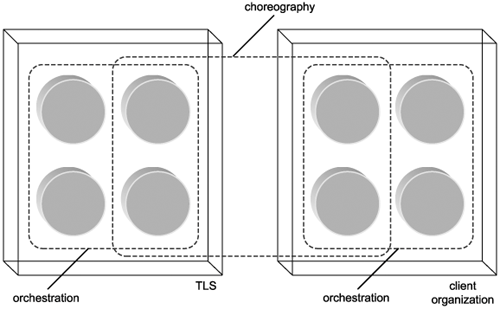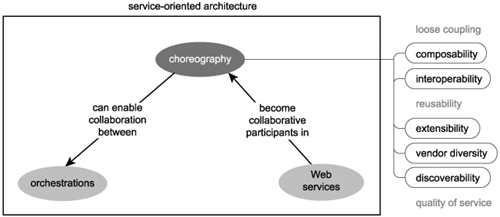Choreography
In a perfect world, all organizations would agree on how internal processes should be structured, so that should they ever have to interoperate, they would already have their automation solutions in perfect alignment.
Though this vision has about a zero percent chance of ever becoming reality, the requirement for organizations to interoperate via services is becoming increasingly real and increasingly complex. This is especially true when interoperation requirements extend into the realm of collaboration, where multiple services from different organizations need to work together to achieve a common goal.
The Web Services Choreography Description Language (WS-CDL) is one of several specifications that attempts to organize information exchange between multiple organizations (or even multiple applications within organizations), with an emphasis on public collaboration (Figure 6.37). It is the specification we've chosen here to represent the concept of choreography and also the specification from which many of the terms discussed in this section have been derived.
Figure 6.37. A choreography enables collaboration between its participants.

6.7.1. Collaboration
An important characteristic of choreographies is that they are intended for public message exchanges. The goal is to establish a kind of organized collaboration between services representing different service entities, only no one entity (organization) necessarily controls the collaboration logic. Choreographies therefore provide the potential for establishing universal interoperability patterns for common inter-organization business tasks.
Note
While the emphasis on choreography is B2B interaction, it also can be applied to enable collaboration between applications belonging to a single organization. The use of orchestration, though, is far more common for this requirement.
6.7.2. Roles and participants
Within any given choreography, a Web service assumes one of a number of predefined roles. This establishes what the service does and what the service can do within the context of a particular business task. Roles can be bound to WSDL definitions, and those related are grouped accordingly, categorized as participants (services).
6.7.3. Relationships and channels
Every action that is mapped out within a choreography can be broken down into a series of message exchanges between two services. Each potential exchange between two roles in a choreography is therefore defined individually as a relationship. Every relationship consequently consists of exactly two roles.
Now that we've defined who can talk with each other, we require a means of establishing the nature of the conversation. Channels do exactly that by defining the characteristics of the message exchange between two specific roles.
Further, to facilitate more complex exchanges involving multiple participants, channel information can actually be passed around in a message. This allows one service to send another the information required for it to be communicated with by other services. This is a significant feature of the WS-CDL specification, as it fosters dynamic discovery and increases the number of potential participants within large-scale collaborative tasks.
6.7.4. Interactions and work units
Finally, the actual logic behind a message exchange is encapsulated within an interaction. Interactions are the fundamental building blocks of choreographies because the completion of an interaction represents actual progress within a choreography. Related to interactions are work units. These impose rules and constraints that must be adhered to for an interaction to successfully complete.
6.7.5. Reusability, composability, and modularity
Each choreography can be designed in a reusable manner, allowing it to be applied to different business tasks comprised of the same fundamental actions. Further, using an import facility, a choreography can be assembled from independent modules. These modules can represent distinct sub-tasks and can be reused by numerous different parent choreographies (Figure 6.38).
Figure 6.38. A choreography composed of two smaller choreographies.

Finally, even though a choreography in effect composes a set of non-specific services to accomplish a task, choreographies themselves can be assembled into larger compositions.
6.7.6. Orchestrations and choreographies
While both represent complex message interchange patterns, there is a common distinction that separates the terms "orchestration" and "choreography." An orchestration expresses organization-specific business workflow. This means that an organization owns and controls the logic behind an orchestration, even if that logic involves interaction with external business partners. A choreography, on the other hand, is not necessarily owned by a single entity. It acts as a community interchange pattern used for collaborative purposes by services from different provider entities (Figure 6.39).
Figure 6.39. A choreography enabling collaboration between two different orchestrations.

One can view an orchestration as a business-specific application of a choreography. This view is somewhat accurate, only it is muddled by the fact that some of the functionality provided by the corresponding specifications (WS-CDL and WS-BPEL) actually overlaps. This is a consequence of these specifications being developed in isolation and submitted to separate standards organizations (W3C and OASIS, respectively).
An orchestration is based on a model where the composition logic is executed and controlled in a centralized manner. A choreography typically assumes that there is no single owner of collaboration logic. However, one area of overlap between the current orchestration and choreography extensions is the fact that orchestrations can be designed to include multi-organization participants. An orchestration can therefore effectively establish cross-enterprise activities in a similar manner as a choreography. Again, though, a primary distinction is the fact that an orchestration is generally owned and operated by a single organization.
6.7.7. Choreography and SOA
The fundamental concept of exposing business logic through autonomous services can be applied to just about any implementation scope. Two services within a single organization, each exposing a simple function, can interact via a basic MEP to complete a simple task. Two services belonging to different organizations, each exposing functionality from entire enterprise business solutions, can interact via a basic choreography to complete a more complex task. Both scenarios involve two services, and both scenarios support SOA implementations.
Choreography therefore can assist in the realization of SOA across organization boundaries (Figure 6.40). While it natively supports composability, reusability, and extensibility, choreography also can increase organizational agility and discovery. Organizations are able to join into multiple online collaborations, which can dynamically extend or even alter related business processes that integrate with the choreographies. By being able to pass around channel information, participating services can make third-party organizations aware of other organizations with which they already have had contact.
Figure 6.40. Choreography relating to other parts of SOA.

|
SUMMARY OF KEY POINTS |
|---|
|
Introduction
- Why this book is important
- Objectives of this book
- Who this book is for
- What this book does not cover
- How this book is organized
- Additional information
Case Studies
- Case Studies
- How case studies are used
- Case #1 background: RailCo Ltd.
- Case #2 background: Transit Line Systems Inc.
Part I: SOA and Web Services Fundamentals
Introducing SOA
- Introducing SOA
- Fundamental SOA
- Common characteristics of contemporary SOA
- Common misperceptions about SOA
- Common tangible benefits of SOA
- Common pitfalls of adopting SOA
The Evolution of SOA
- The Evolution of SOA
- An SOA timeline (from XML to Web services to SOA)
- The continuing evolution of SOA (standards organizations and contributing vendors)
- The roots of SOA (comparing SOA to past architectures)
Web Services and Primitive SOA
- Web Services and Primitive SOA
- The Web services framework
- Services (as Web services)
- Service descriptions (with WSDL)
- Messaging (with SOAP)
Part II: SOA and WS-* Extensions
Web Services and Contemporary SOA (Part I: Activity Management and Composition)
- Web Services and Contemporary SOA (Part I: Activity Management and Composition)
- Message exchange patterns
- Service activity
- Coordination
- Atomic transactions
- Business activities
- Orchestration
- Choreography
Web Services and Contemporary SOA (Part II: Advanced Messaging, Metadata, and Security)
- Web Services and Contemporary SOA (Part II: Advanced Messaging, Metadata, and Security)
- Addressing
- Reliable messaging
- Correlation
- Policies
- Metadata exchange
- Security
- Notification and eventing
Part III: SOA and Service-Orientation
Principles of Service-Orientation
- Principles of Service-Orientation
- Service-orientation and the enterprise
- Anatomy of a service-oriented architecture
- Common principles of service-orientation
- How service-orientation principles inter-relate
- Service-orientation and object-orientation (Part II)
- Native Web service support for service-orientation principles
Service Layers
- Service Layers
- Service-orientation and contemporary SOA
- Service layer abstraction
- Application service layer
- Business service layer
- Orchestration service layer
- Agnostic services
- Service layer configuration scenarios
Part IV: Building SOA (Planning and Analysis)
SOA Delivery Strategies
- SOA Delivery Strategies
- SOA delivery lifecycle phases
- The top-down strategy
- The bottom-up strategy
- The agile strategy
Service-Oriented Analysis (Part I: Introduction)
- Service-Oriented Analysis (Part I: Introduction)
- Service-oriented architecture vs. Service-oriented environment
- Introduction to service-oriented analysis
- Benefits of a business-centric SOA
- Deriving business services
Service-Oriented Analysis (Part II: Service Modeling)
- Service-Oriented Analysis (Part II: Service Modeling)
- Service modeling (a step-by-step process)
- Service modeling guidelines
- Classifying service model logic
- Contrasting service modeling approaches (an example)
Part V: Building SOA (Technology and Design)
Service-Oriented Design (Part I: Introduction)
- Service-Oriented Design (Part I: Introduction)
- Introduction to service-oriented design
- WSDL-related XML Schema language basics
- WSDL language basics
- SOAP language basics
- Service interface design tools
Service-Oriented Design (Part II: SOA Composition Guidelines)
- Service-Oriented Design (Part II: SOA Composition Guidelines)
- Steps to composing SOA
- Considerations for choosing service layers
- Considerations for positioning core SOA standards
- Considerations for choosing SOA extensions
Service-Oriented Design (Part III: Service Design)
- Service-Oriented Design (Part III: Service Design)
- Service design overview
- Entity-centric business service design (a step-by-step process)
- Application service design (a step-by-step process)
- Task-centric business service design (a step-by-step process)
- Service design guidelines
Service-Oriented Design (Part IV: Business Process Design)
- Service-Oriented Design (Part IV: Business Process Design)
- WS-BPEL language basics
- WS-Coordination overview
- Service-oriented business process design (a step-by-step process)
Fundamental WS-* Extensions
- Fundamental WS-* Extensions
- You mustUnderstand this
- WS-Addressing language basics
- WS-ReliableMessaging language basics
- WS-Policy language basics
- WS-MetadataExchange language basics
- WS-Security language basics
SOA Platforms
Appendix A. Case Studies: Conclusion
EAN: 2147483647
Pages: 150
